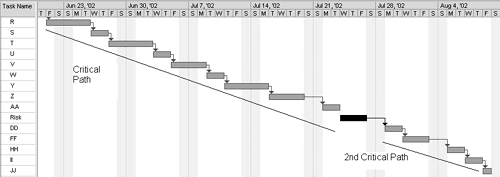| Generally 20 to 30 tasks along the critical path are used to create a risk factor. Such calculations, tempered with considerations of step-function contributions, are highly reliable. The risk factor will be added as a task bar on the Gantt chart at the end of the string of critical tasks, before the first task in the next task string is started (see Figures 8-4A and 8-4B).
Figure 8-4A. 
Figure 8-4B. 
The reason for using no more than 30 critical path tasks when calculating a risk factor is related to the good results that come from calculating and inserting risk factors periodically along the project's timeline. In practice, a few of the 20 or 30 tasks will run over, and for each overrun the project leader will have to inform downstream task leaders and help them adjust their start dates. Most, but seldom all, of the cushion provided by the risk factor will be used. For a 30-task critical path string, the leader of Task 29 does not expect to start work as originally planned. Instead, the Task 29's start date will be delayed by almost the full amount of the risk factor. Thus, most task leaders will have a realistic, narrow band of startup dates and can adjust them accordingly. Task 31's task leader knows exactly when to expect to begin work. The prior risk factor has absorbed all upstream task delays. Therefore, he or she can start the day after the risk factor ends. The risk factor will be largely used up by the task overruns. Generally, a small percentage is not used. It is not effective to try to start tasks by half of a day or day early, simply because conditions are ready for a startup. Efficiency is gained when task leaders know their startups will not be hurried. Occasionally, one critical path task finishes sooner than predicted. If no risk factor time has been used, it will not impact downstream start dates. However, if some of the risk factor has been used, the amount of time saved will automatically be added back to the risk factor to cover overruns further down the critical path string of tasks. Project management software with the risk factor entered on the Gantt chart will automatically enter this time amount as the actual task times are entered during the project's execution. If there are fewer than 20 tasks on a critical path, the procedure for calculating contributions and adding them together to determine a risk factor becomes less reliable. The averaging out of overruns and timely finishes of tasks achieved by the procedure is less certain with a few number of tasks. To protect from having the project overrun its estimated completion date when the critical path is between 10 and 20 tasks long, add 20 percent to the risk factor. If the critical path is less than 10 tasks long, lay out each task's task overrun D versus. "Likelihood of completion overrun Y timechart as best you can with the task leader's help. Estimate the risk factor based on the characteristics of this task group. If all of the tasks have an overrun characteristic (Y) of 20 percent or less, determine a risk factor in the conventional way and double it. If the likelihood runs above 20 percent, you will probably want to triple the risk factor. If one task has a large D and an overrun likelihood of over 20 percent or a step-function overrun characteristic, use that task's D as your risk factor. Using these rules of thumb and if the decision is tempered by good judgment, your project may end up finishing early, but it will be protected from overrun. |